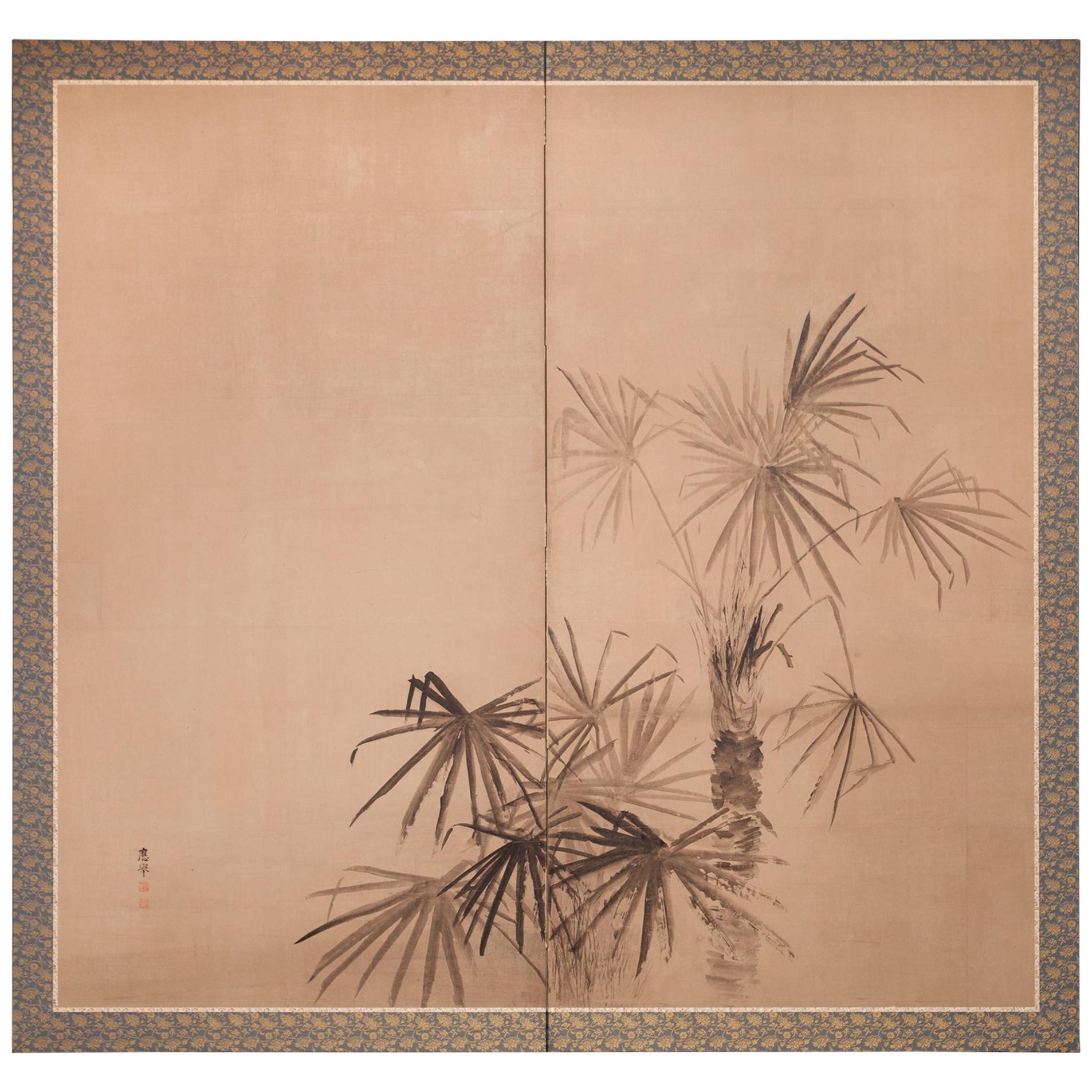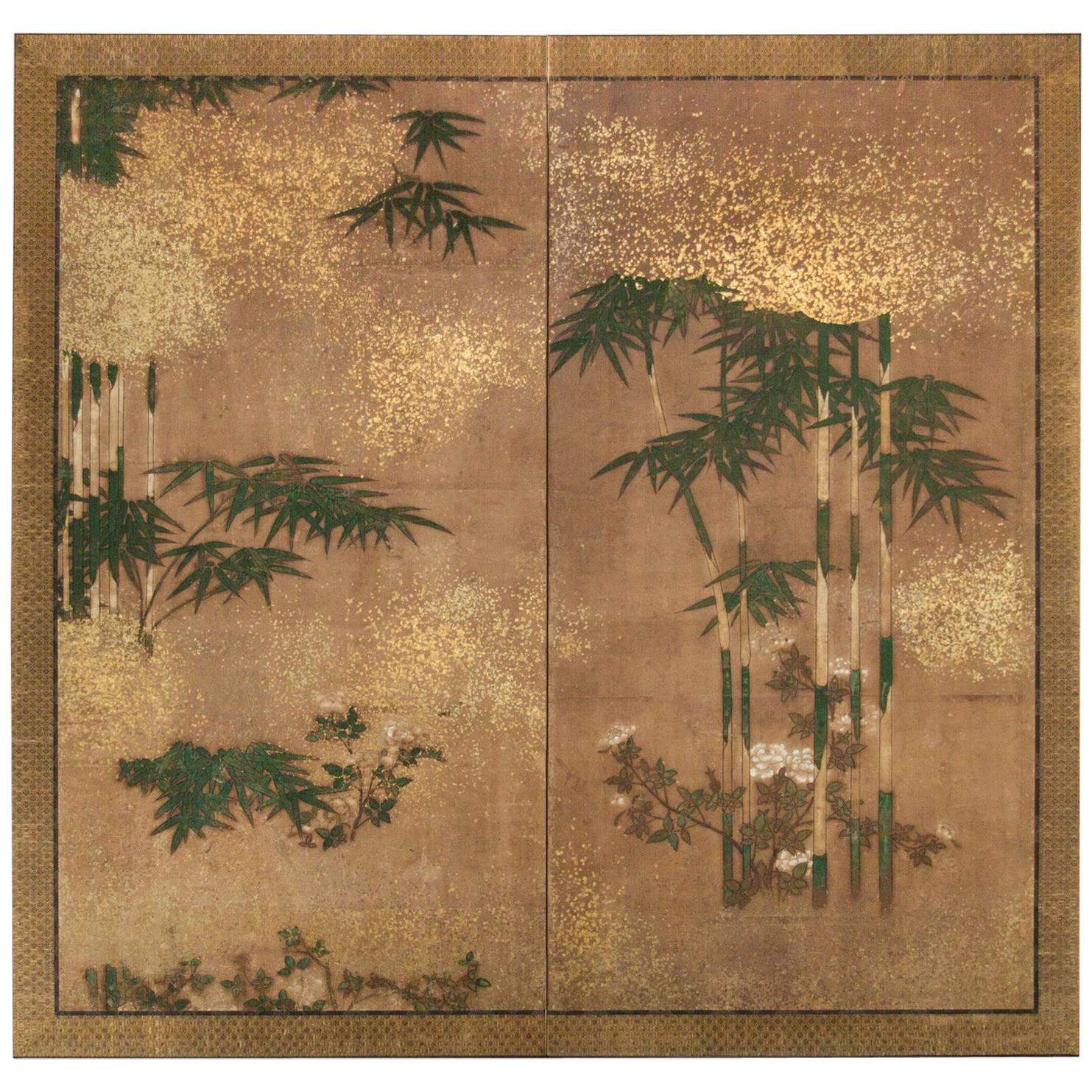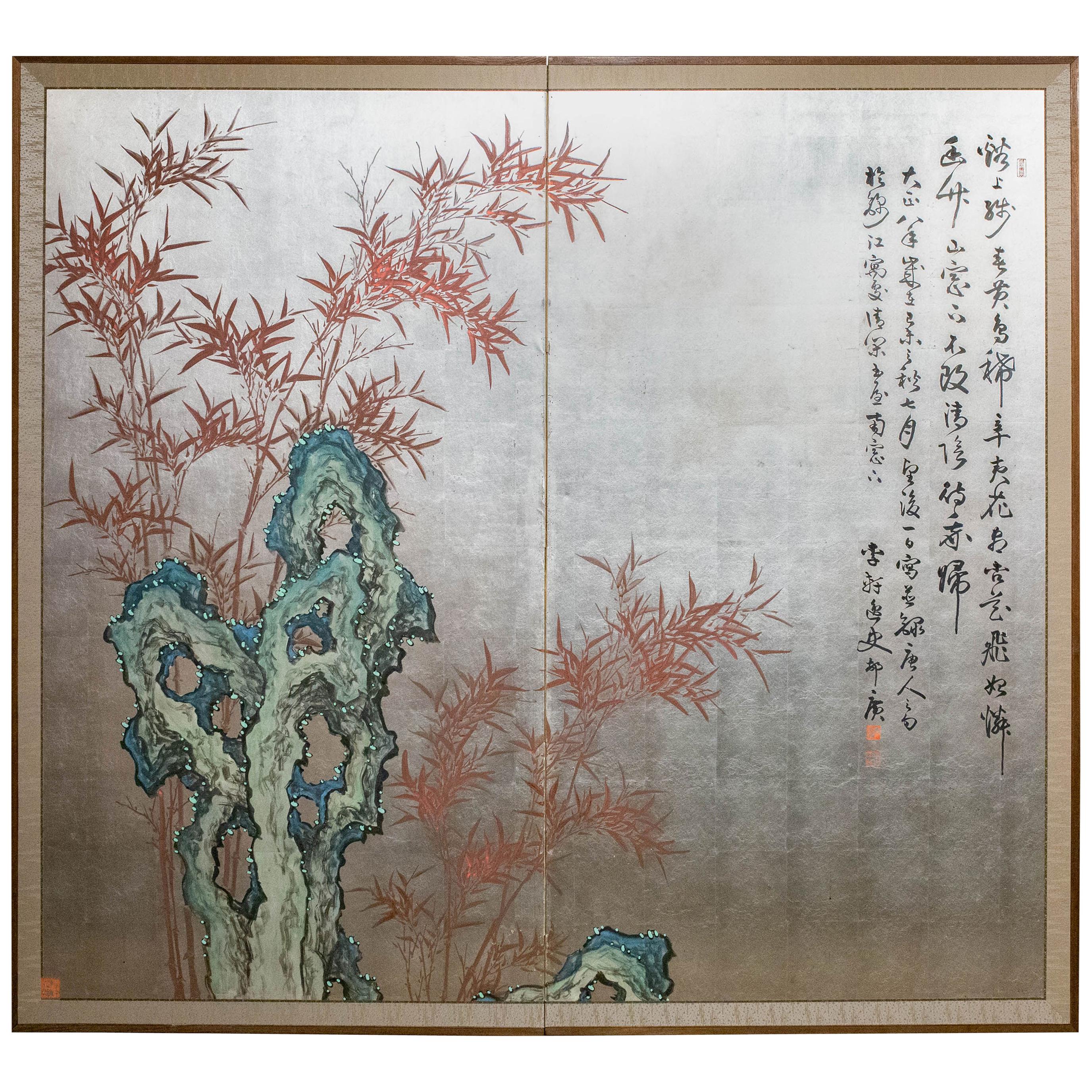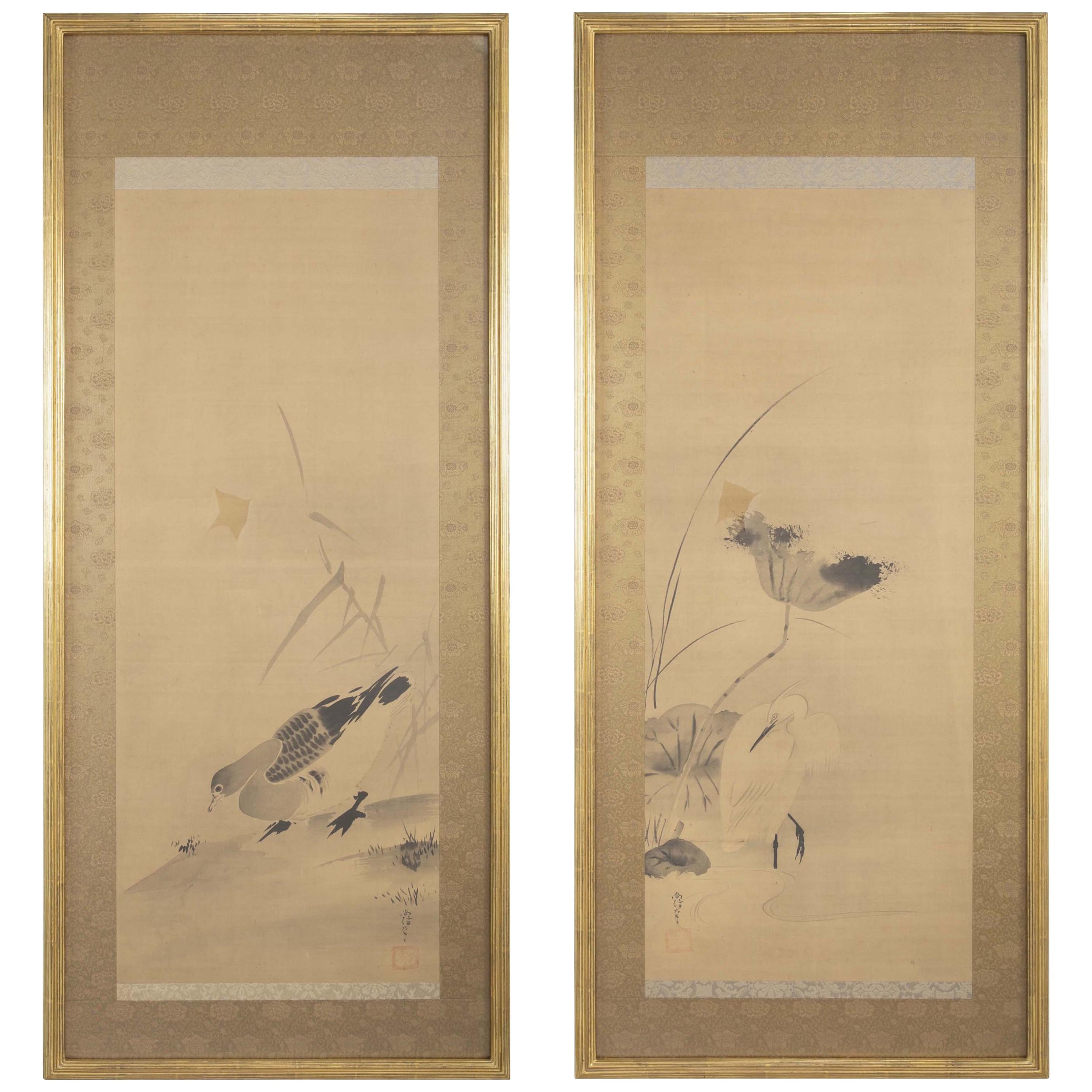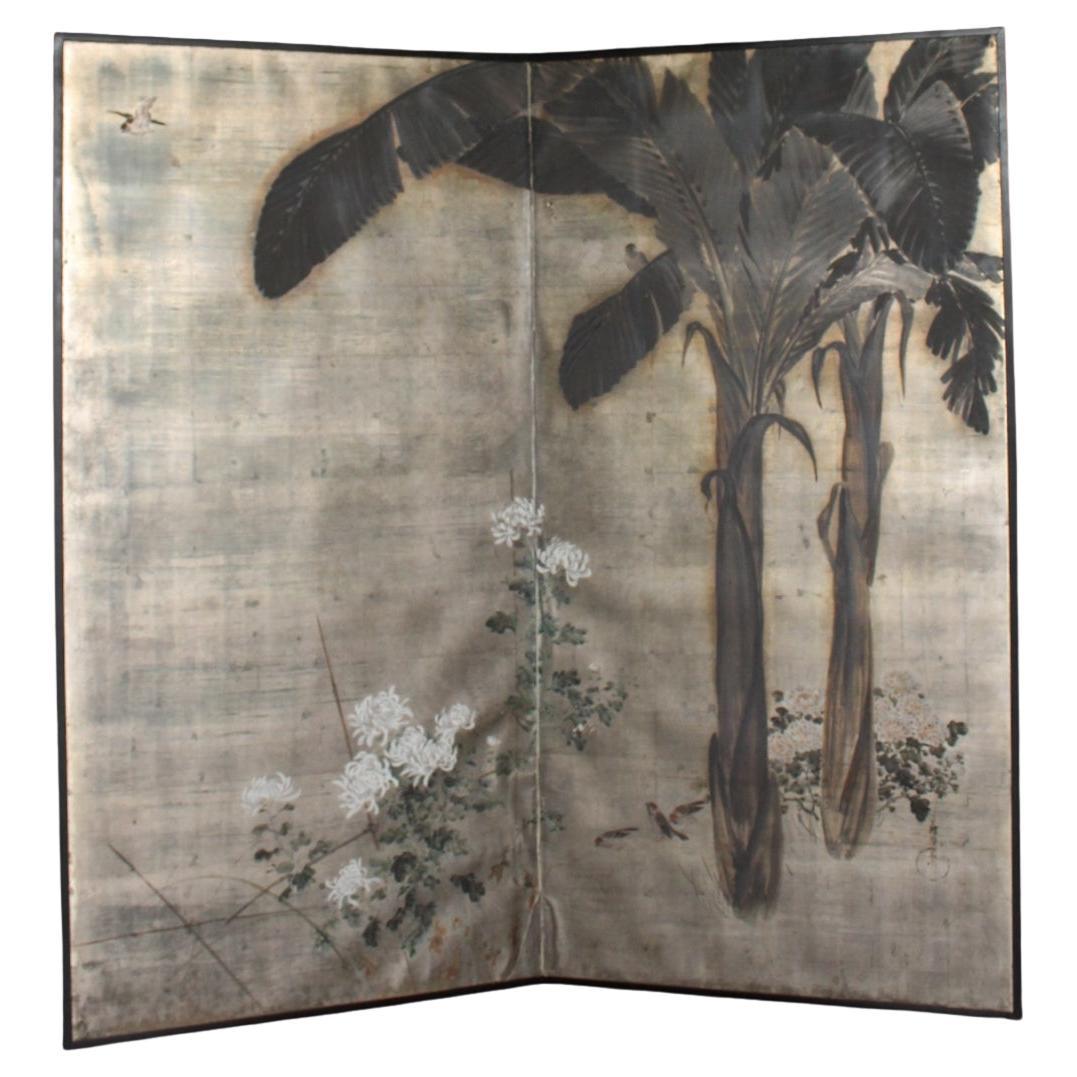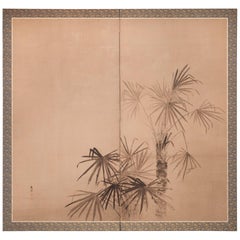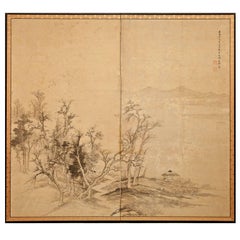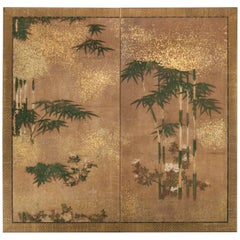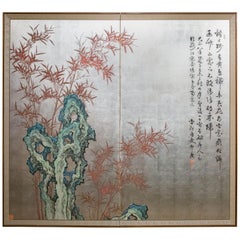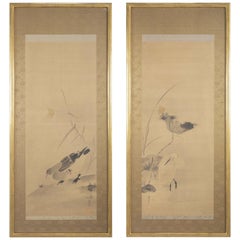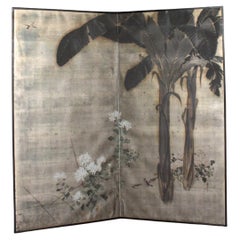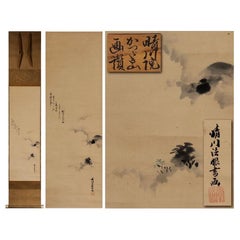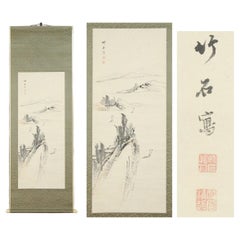Items Similar to Japanese Two Panel Screen Ink Painting of Banana Leaves on Mulberry Paper
Want more images or videos?
Request additional images or videos from the seller
1 of 7
Japanese Two Panel Screen Ink Painting of Banana Leaves on Mulberry Paper
$29,500
£22,191.07
€25,707.33
CA$41,588.89
A$46,249.62
CHF 24,274.87
MX$563,991.92
NOK 306,786.21
SEK 287,624.29
DKK 191,876.41
About the Item
Edo period (dated 1787) beautiful painting of unfurling palm leaves with romping puppies in the background. Ink painting (sumi-e) on mulberry paper. Signature reads: Okyo. Calligraphy reads: 1787 middle of Spring.
- Dimensions:Height: 71 in (180.34 cm)Width: 74 in (187.96 cm)Depth: 0.75 in (1.91 cm)
- Style:Edo (Of the Period)
- Materials and Techniques:
- Place of Origin:
- Period:
- Date of Manufacture:circa 1787
- Condition:Most items that are 100 years old have been cleaned or polished in their lifetime. More involved restorations are mentioned in the above description. For a detailed condition report and a video of this item please contact us directly. -Naga Antiques.
- Seller Location:Hudson, NY
- Reference Number:Seller: S14141stDibs: LU855123489122
About the Seller
5.0
Recognized Seller
These prestigious sellers are industry leaders and represent the highest echelon for item quality and design.
Established in 1971
1stDibs seller since 2008
166 sales on 1stDibs
Typical response time: 8 hours
Associations
The Art and Antique Dealers League of AmericaAntiques Associations Members
- ShippingRetrieving quote...Shipping from: Craryville, NY
- Return Policy
Authenticity Guarantee
In the unlikely event there’s an issue with an item’s authenticity, contact us within 1 year for a full refund. DetailsMoney-Back Guarantee
If your item is not as described, is damaged in transit, or does not arrive, contact us within 7 days for a full refund. Details24-Hour Cancellation
You have a 24-hour grace period in which to reconsider your purchase, with no questions asked.Vetted Professional Sellers
Our world-class sellers must adhere to strict standards for service and quality, maintaining the integrity of our listings.Price-Match Guarantee
If you find that a seller listed the same item for a lower price elsewhere, we’ll match it.Trusted Global Delivery
Our best-in-class carrier network provides specialized shipping options worldwide, including custom delivery.More From This Seller
View AllJapanese Two-Panel Screen Ink Painting of Palm Trees on Paper
Located in Hudson, NY
Japanese two-panel screen: ink painting of Palm Trees on paper, Edo period (1787) beautiful painting of Japanese windmill palm trees. Ink paint...
Category
Antique 18th Century Japanese Edo Paintings and Screens
Materials
Silk, Wood, Paper
Japanese Two-Panel Screen: Ink Landscape on Silk
By Shunyu
Located in Hudson, NY
Japanese Two Panel Screen: Ink Landscape on Silk, Meiji period (1868 - 1912) painting of a man riding a mule on a pathway through the Kurotani mountains with a thatched roof shelter ...
Category
Antique 19th Century Japanese Meiji Paintings and Screens
Materials
Silk, Wood
Japanese Two Panel Screen: Bamboo Grove on Mulberry Paper with Gold Dust
Located in Hudson, NY
Kano School painting of a bamboo grove with blooming flowers and gold dust mists. Painted in mineral pigments on mulberry paper with gold dust and a silk brocade border.
Category
Antique Early 19th Century Japanese Edo Paintings and Screens
Materials
Gold
Japanese Two-Panel Screen Chinese Style Painting with Calligraphy
Located in Hudson, NY
Painting of a perforated garden stone with red bamboo growing behind. Chinese zekku poem reads, "Returning home to my grass hut on a spring evening," by the Tang-poet Qian Qi. Screen...
Category
Early 20th Century Japanese Taisho Paintings and Screens
Materials
Silk, Paper, Wood
Japanese Two Panel Screen: Garden Scene
Located in Hudson, NY
Bamboo, chrysanthemums and garden stone in mineral pigments on a gold silk ground. Black lacquer trim with well patinaed bronze hardware. Signature and seals read: Seido Senshi
Category
Early 20th Century Japanese Paintings and Screens
Materials
Bronze
Japanese Two Panel Screen: Bamboo Grove on Mulberry Paper with Gold Dust
Located in Hudson, NY
Kano School painting of a bamboo grove with blooming flowers and gold dust mists. Painted in mineral pigments on mulberry paper with gold dust and a silk brocade border.
Category
Antique Early 19th Century Japanese Paintings and Screens
Materials
Gold
You May Also Like
Pair of Japanese Framed Scrolls with Lotus, White Heron and Duck Decoration
Located in Stamford, CT
Pair of 19th century Japanese scrolls in frames with lotus, white heron circle of Kano Naonobu (Japan, 1607-1660) and duck beside a pond.
Category
Antique Mid-19th Century Japanese Paintings and Screens
Materials
Paper
B1 Japanese Antiques 2panels, Silver back, Banana Plants, Rofuu folding Screen
Located in Niiza, JP
Material: Silver paper, wooden frame
One sheet: W870×H1740mm, unfolded size: W1740mm, 5kg
Folded size: W870×H1740×D35mm
Estimated packaging (sandwiched with 5-10mm plywood): 12cm x 1...
Category
Antique 19th Century Japanese Paintings and Screens
Materials
Paper
Lovely Japanese 18/19th c Edo Scroll Kano Osanobu Nihonga Painting Mountain
Located in Amsterdam, Noord Holland
Kano Osanobu (狩野養信)
Osanobu Kano (born August 18, 1796; died June 12, 1846) was the ninth painter of the Kobikicho Kano School in the Edo period. His common name was Shozaburo. His father was Naganobu KANO, and Tadanobu KANO was his son. His Go (pen name) was Osanobu Seisenin, Kaishinsai, and Gyokusen.
Brief Personal History
He was born the eldest son of Naganobu ISENIN during the Edo period. He was first sent to serve at Edo Castle at the age of 15, and it appears that he was apparently pushed by his father to perform various public tasks for the Kanon School. He kept a diary for 36 years, starting from the day before he first went into service at Edo Castle until the day before he died. The diary is entitles "Official Service Diary" (it consists of 52 volumes that are maintained at the Tokyo National Museum, and 4 volumes that are separately maintained at the different families), and have become the focus of a lot of attention in recent years for the detailed information they present on the daily life and work of a prestigious official painter. The reading of the characters of his name was originally "Takenobu"; however, with the birth of the first son of the Shongun Ieyoshi TOKUGAWA in 1813, whose name was Takechiyo, having a sylable with the same pronunciation of "Take"was deemed to be inappropriate, and was therefore changed to "Osanobu". Because Takenobu died the following year, after which he was referred to as Gyokujuin, Osanobu changed his pen name Gyokusen he had used until that point to Seisenin, in order to avoid using the same Chinese charcter pronounced alike. In 1819, he attained the second highest rank for a Buddhist priest, Hogen, and assumed the role of head of the family after his father passed away in 1828. In 1834 he attained the highest rank for a Buddhist priest, Hoin. He oversaw the rennovation of the wall paintings of Nishinomaru Palace of Edo Castle from 1838 to 1839, and Honmaru Palace of it from 1844 to 1846. It is thought that Osanobu later died due to the fatigue...
Category
Antique 18th Century Edo Paintings
Materials
Silk
$1,717 Sale Price
20% Off
Japanese Painting 18c Edo Scroll Chikuseki Nagamachi Nihonga Landscape Painting
Located in Amsterdam, Noord Holland
[Authentic Artwork] ◆ Nagamachi Chikuseki ◆ Landscape ◆ Edo Period ◆ Mitsuishi Origin ◆ Kagawa Prefecture ◆ Handwritten ◆ Paperback ◆ Hanging Scroll ◆ k891 ◆ Nagamachi Chikuseki
Explore the artistry of Chikuseki Nagamachi...
Category
Antique 18th Century Edo Paintings
Materials
Silk
$1,812 Sale Price
20% Off
Japanese Nihonga Painting 19th c Edo Scroll by Seiki Yokoyama Landscape Shijo
Located in Amsterdam, Noord Holland
[Authentic work] ◆ Seiki Yokoyama ◆ Landscape ◆ Rural landscape ◆ Japanese painting ◆ Shijo school ◆ Hand-painted ◆ Paperback ◆ Hanging scroll ◆
Seiki Yokoyama
[Art yearbook appra...
Category
Antique 19th Century Edo Paintings
Materials
Silk
$1,239 Sale Price
20% Off
Japanese Ink and Watercolor 4-Panel Floor Screen
Located in Astoria, NY
Japanese Four-Panel Floor Screen, Ink and Watercolor on Paper, mounted on board, depicting mountainous landscape scene with seaside village. Panel: 55.25" H x 24.75" W; whole: 99" W....
Category
20th Century Japanese Meiji Paintings and Screens
Materials
Wood, Paint, Paper
More Ways To Browse
Beautiful Antique Painting
18th Century Hand Screen
Antique Japanese Calligraphy
18th Century Japanese Screens
Antique Banana
Calligraphy
Japanese Calligraphy Screen
Japanese Puppies
Gold Leaf Screen
Japanese Painted Silk
Antique Silk Screen
Edo Period Japanese Painting
Asian Wood Screen Panels
Asian Silk Paintings Antique
Japanese Scroll Art
Asian Black Screens
Japanese Silk Paintings
Silk Panel Framed
